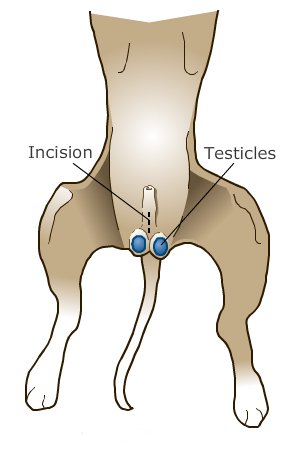Whether you’ve recently adopted a pet or you’re considering it, one of the most important health decisions you’ll make is to spay or neuter your cat or dog. One of the main benefits is you will be helping control the pet homelessness crisis, which results in millions of healthy dogs and cats being euthanized in Canada and the United States each year simply because there aren’t enough homes to go around. In addition, there are also medical and behavioral benefits to spaying and neutering. Both of these surgeries are day-procedures where the surgery is completed in the morning and your pet is ready to return home in the afternoon. They are offered at both our hospitals. The option of using a CO2 Laser is available for neuters and spays, and is heavily recommended for spays, especially in mature dogs.
Neuter
- Neutering is the surgical removal of the the testicles of your male. At our hospitals, a small prescrotal incision is made facilitating access to both testicles. There are many benefits to having a neutered male pet:
- Neutering fights pet overpopulation.
- Some cancers including testicular cancer are prevented with neutering,
- An intact male will do just about anything to find a mate! That includes digging his way under the fence and making like Houdini to escape from the house. And once he’s free to roam, he risks injury in traffic and fights with other males.
- Neutered cats and dogs focus their attention on their human families. On the other hand, unneutered dogs and cats may mark their territory by spraying strong-smelling urine all over the house. Many behavioural problems can be avoided or addressed with the removal of testosterone, including anxiety, aggression, roaming, marking, and hyperactivity.
- Neutering can prevent problems later in life. Intact senior males commonly suffer from perineal hernias and urinary problems when their prostate enlarges and presses on their urethra causing them to have a difficult time urinating.
Spay
- Spaying is the surgical removal of the ovaries and uterus of a female It is performed through an abdominal incision giving access to the abdominal cavity where the ovaries and uterus are located, which are then removed in their entirety. There are many benefits to having a spayed female pet:
- Spaying helps fight pet overpopulation.
- Avoid the mess and behavioural changes associated with a heat cycle. Spaying eliminates the objectionable behavior exhibited by female cats in heat who yowl, cry as if in pain, and may urinate in the house as they seek a male to mate with. (They attract males who will also mark by spraying urine.)
- Reduce some types of cancers, including mammary and ovarian cancer
- Spaying eliminates the potential for pyometra (infected uterus) which is common in older intact females
Timing
The timing of when to spay or neuter your pet varies from case to case. For male and female cats, we recommend spaying before they reach puberty – fixing them at 5 to 6 month is ideal. For dog, the timing for spaying and neutering depends on the breed, size of dog, age of sexual and developmental maturity, and the risks and benefits involved at undergoing the procedure at different ages. Please speak to our veterinarians during your puppy appointments for more information and together, we can choose an age to fix your pet that offers the most benefits and minimizes risks and complications in the future.
Anesthesia
For our spays and neuters, we ensure to minimize anesthetic risk. The risk for neutering male cats is minimal as the procedure only takes a few minutes, but for male dogs and female dogs and cats, the procedure can take much longer. Each patient is monitored throughout the procedure by a registered veterinary technician who monitors you pets vitals including blood pressure, heart rate, temperature, respiratory rate, and SPO2. Risk is minimized by using IV fluids to maintain hydration and heating pads to avoid hypothermia. Hypotension risk is also minimized with a CRI pump that enables continuous administration of medications that increase blood pressure if needed. Pre-anesthetic bloodwork is included in the price of surgery except for cat neuters (since the procedure is rapid) to ensure adequate organ function and blood values that are conducive to enabling a longer anesthetic procedure.
Please call our offices today for more information. Microchipping is also available and recommended at the time of surgery because your pet will already be anesthetized thus not feeling any pain associated with microchip placement.



